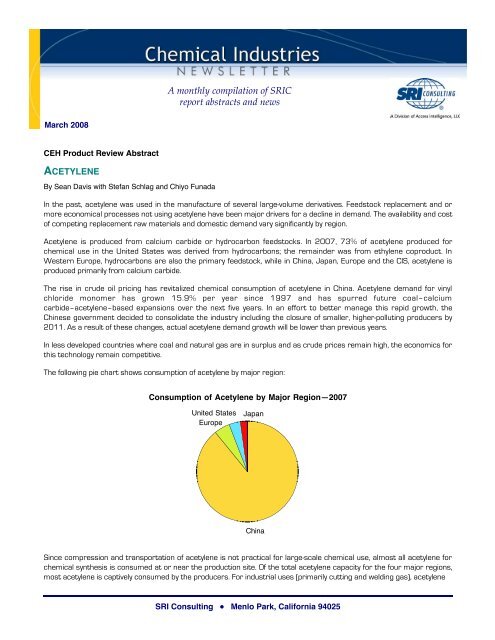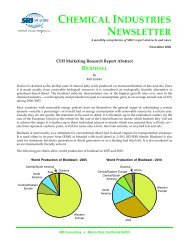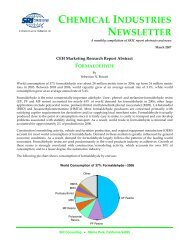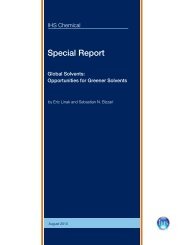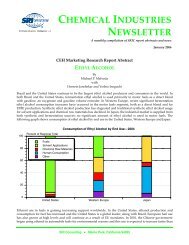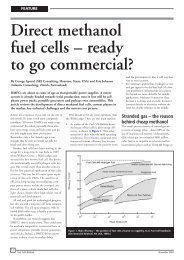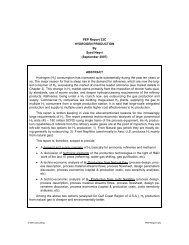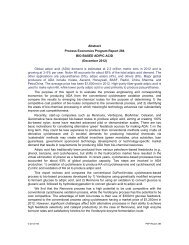Download - Chemical Insight & Forecasting
Download - Chemical Insight & Forecasting
Download - Chemical Insight & Forecasting
Create successful ePaper yourself
Turn your PDF publications into a flip-book with our unique Google optimized e-Paper software.
<strong>Chemical</strong> Industries Newsletter March 2008CEH Marketing Research Report AbstractDYESBy Yosuke Ishikawa with James Glauser and Hossein JanshekarDuring the last decade, production of dyes in the United States (excluding fluorescent whitening agents), Western Europeand Japan decreased significantly, while production in Asian countries, particularly in China, increased. Consumption ofdyes in Western Europe and Japan also decreased during the same period, while it increased primarily in China and otherAsian countries including India, Thailand and Indonesia.Consumption of dyestuffs is governed predominantly by several factors. The primary long-term factor is demand fortextiles, leather and colored paper. Consumption of textiles, the largest end-use market for dyestuffs, in turn dependsdirectly on population growth and private (consumer) spending levels. The most important short-term factor is fashion,which dictates the types of colors used. The quantity of dyestuffs consumed per volume of textile is considerably higherwhen bright or dark colors are desired in textiles than when only light colors are in demand. Hence, the colors used fortextiles have an impact on the total consumption of dyestuffs. A lesser but still potentially important factor is thesubstitutability of organic pigments for dyes, particularly in the textile printing segment but also in other segments such asplastics and inks. On the other hand, specialty dyestuffs may also substitute for pigments in selected markets; an exampleis the dyeing of modified polypropylene fibers, which are normally pigmented.In recent years, new legislation has affected dyestuff producers’ product portfolios. For instance, the EuropeanCommission banned many azo dyes in 2002 and navy blue (a chromate-based azo dye, one of the most widely used dyesin the leather industry) in June 2004. REACH (an EU regulation of chemicals), which was enacted in 2007, also affectsconsumption of synthetic dyes.The following pie chart shows world consumption of dyes:World Consumption of Dyes—2007Middle EastCentral AmericaMexicoCentral/Eastern EuropeJapanCanadaOtherWestern EuropeChinaSouth AmericaIndiaOtherAsiaUnitedStatesAnnual per capita consumption of dyes had been considerably greater in the United States (more than 500 grams perperson) than in developing countries (e.g., India’s per capita consumption is around 50 grams per year) until the early2000s, reflecting greater per capita consumption of textiles in industrialized countries. However, per capita consumptionof textiles is growing at a faster rate in China, India and other developing countries than in the developed countries.Consequently, dye consumption will also grow at a faster rate in the developing countries as their populations increaseand exports of dyed textiles to developed countries continue to grow.Visit us at www.sriconsulting.com 3
March 2008<strong>Chemical</strong> Industries NewsletterDuring the last decade, the worldwide dyestuff industry has been characterized by significant oversupply, resulting insevere pressure on prices. As a result, most dyestuffs producers have suffered significant financial losses and majorrestructuring has taken place, especially in the United States, Western Europe and East Asia including Japan, theRepublic of Korea, and Taiwan. The current situation is not expected to change dramatically, as most small to mediumsizedplayers, particularly in Asia (including Indonesia and Thailand), are expected to continue to produce regardless offinancial returns. On the demand side, significant and sustainable growth of the dyestuffs market can be expected only inAsia. The migration of low- and medium-quality textile production (as well as for the leather industry) to lower-costcountries is expected to continue, demanding further and often painful adjustments for international dyestuff producers.Another important factor that has affected producers in the more industrialized countries is the rising cost of disposing ofrelatively high quantities of hazardous organic wastes generated during production. Thus, international traditional dyestuffproducers shifted and/or migrated their production facilities to Southeast Asian countries and China during the past twodecades. However, ownership of these producers has been ever changing in recent years.The dyestuff industry clearly faces numerous challenges in this decade, but ample opportunities will also presentthemselves for the most agile and innovative producers.(For the complete marketing research report on DYES, visit this report’s home page or see p. 520.5000 A of the <strong>Chemical</strong> EconomicsHandbook.)CEH Product Review AbstractFURFURALBy Ralf Gubler with Kazuteru YokoseFurfural is produced from agricultural wastes that contain pentosans, which are hydrolyzed to furfural and other byproducts.Pentosans are hemicelluloses (complex carbohydrates) that are present within the cellulose in many woodyplant tissues. The most common raw materials for furfural production include corncobs, bagasse from sugarcaneprocessing, and by-product streams from tanning and cellulosic fiber production.Most furfural plants are located close to available raw materials. Few operate on a twelve-month basis, with mostoperating on a seven- to eight-month schedule, coinciding with the harvest of agricultural products. Most of the output iseither converted to furfuryl alcohol for furan resin production, used as such in lube oil refining or butadiene extraction, orexported.About 74% of the world’s furfural production capacity is located in China, as of January 1, 2008. Other importantcountries with furfural production include the Dominican Republic and South Africa. Together, these three countriesaccount for about 90% of worldwide installed furfural production capacity.The global furfural market was in large imbalance over the past couple of years, driven mostly by the uncontrolled growthof Chinese furfural capacity. To bring the global furfural market back into balance, China needed to build alternativemarkets for furan resins and to consume large amounts of the material domestically. China’s move in this direction beganduring 2006 and 2007, when three furfural-to-tetrahydrofuran/PTMEG plants came on stream.In 2007, furfural supply to its traditional main market outlet—furfuryl alcohol—got even tighter as a result of the combinedeffect of increased regulations in China leading to a temporary shutdown of a significant amount of furfural productioncapacity, significant domestic consumption of furfural for PTMEG production and increasing competition for pentosancontainingraw materials with domestic xylitol producers.4 Visit us at www.sriconsulting.com
<strong>Chemical</strong> Industries Newsletter March 2008The following pie chart shows world consumption of furfural:World Consumption of Furfural—2007Middle EastCentral/Eastern EuropeCentral/South AmericaAfricaOther AsiaJapanOtherUnitedStatesWesternEuropeChinaAlbeit significant import tariffs protect the U.S. and EU markets, imported furfural from Chinese producers is stillthreatening domestic producers in Western Europe (domestic production of furfural in the United States has been forcedout of business).Significant amounts of furfural could be by-produced from biorefineries in the medium-term future via depolymerization ofthe hemicellulosic content of cellulosic material.(For the complete product review on FURFURAL, visit this report’s home page or see p. 660.5000 A of the <strong>Chemical</strong> Economics Handbook.)CEH Marketing Research Report AbstractFURFURYL ALCOHOL AND FURAN RESINSBy Ralf Gubler with Kazuteru YokoseThe majority of furfuryl alcohol is used primarily in the production of furan resins for foundry sand binders in the metalcasting industry. Furan is a generic term for binders containing furfuryl alcohol and either urea or phenol-formaldehyde, ormixtures of both. Today, furfuryl alcohol is used mainly in binders for the traditional furan no-bake system and in smallerquantities in furan hot-box, warm-box, and gas-hardened processes. In its main application—the foundry business—furfurylalcohol competes primarily with phenol, the feedstock for phenolic resins.China is the world’s largest producer and consumer of furfuryl alcohol, accounting for 67% of worldwide supply and 32%of worldwide demand in 2007. A huge trade surplus of furfuryl alcohol in China in 2007—representing over half ofworldwide demand outside of China—challenged producers around the globe by putting prices under pressure.The following pie chart shows world production of furfuryl alcohol:Visit us at www.sriconsulting.com 5
March 2008<strong>Chemical</strong> Industries NewsletterWorld Production of Furfuryl Alcohol—2007Central/South AmericaAfricaUnited StatesCentral/Eastern EuropeOther AsiaWesternEuropeChinaFurfuryl alcohol prices have a fairly broad fluctuation bandwith, mainly because about 40% of the buyers are smalldomestically operating companies that buy the material on the spot market. Price movements around the globe arelargely dictated by Chinese producers and mainly influenced by the Chinese domestic supply/demand situation.(For the complete marketing research report on FURFURYL ALCOHOL AND FURAN RESINS, visit this report’s home page or see p.661.5000 A of the <strong>Chemical</strong> Economics Handbook.)CEH Product Review AbstractSTYRENIC BLOCK COPOLYMERSBy Uwe Löchner with Issho K. NakamuraStyrenic block copolymers (SBCs) are the largest-volume and lowest-priced member of the thermoplastic elastomers(TPE) family. TPE polymers have rubberlike properties but process as thermoplastics. There are three major types ofSBCs:• Styrene-butadiene-styrene (SBS) block copolymers• Styrene-isoprene-styrene (SIS) block copolymers• Styrene-ethylene-butylene-styrene (SEBS) and other hydrogenated styrenic block copolymersKraton Polymers (formerly a division of Shell <strong>Chemical</strong>) is not only the dominant supplier in the world, it also inventedstyrenic block copolymers more than four decades ago. Its market share has decreased to 23% of total global productioncapacity, because more and more firms have entered the business. Kraton has also missed the opportunity to expandcapacity in Asia to capture a market position comparable with the one the company has in the Americas and Europe. Inparticular, Asian producers have strongly expanded production capacities in the last decade. In 2007 Sinopec (in China)had the second-largest and Lee Chang Yung of Taiwan (with production plants in Taiwan, China and the United States) thethird-largest production capacity in the world.By the end of 2007, the six largest producers—Kraton, Sinopec, Lee Chang Yung, Chi Mei, Dynasol Elastómeros andPolimeri Europa—had 73% of global production capacity.In 2007 the Americas accounted for around 30%, Europe 21% and Asia almost half of the total world market. China isthe leading footwear producer in the world, followed by India, and this industry consumes vast amounts of rubber andelastomers, including styrenic block copolymers, predominantly SBS.The following graph shows consumption of SBCs by end use and major region or country:6 Visit us at www.sriconsulting.com
<strong>Chemical</strong> Industries Newsletter March 2008Consumption of Styrenic Block Copolymers by End Use—2007Relative Market Share in Each RegionAdhesives and SealantsAsphalt ModifiersPolymer ModifiersViscosity Index ImproversFootwearOtherUnited States Western Europe Japan ChinaThe global market is forecast to grow around 4% per year during 2007–2012. Central and Eastern Europe hassurpassed China and East Asia as the largest growth region, in terms of relative growth. Demand growth for SBS in Chinain the shoe industry has shrunk considerably as a result of intermaterial competition with other elastomers.(For the complete product review on STYRENIC BLOCK COPOLYMERS, visit this report’s home page or see p. 525.8600 A of the <strong>Chemical</strong>Economics Handbook.)SCUP REPORTS SCHEDULED FOR 2008Report Title Author StatusSpecialty <strong>Chemical</strong>s Business Overview Uwe Fink In preparationNutraceuticals Laszlo Somogyi In productionHigh Performance Anticorrosion Coatings Eric Linak In productionHigh Performance Thermoplastics Fred Hajduk In preparationLube Oil Additives Stefan Müller In preparationWater Management Ray Will In preparationThermosetting Powder Coatings Eric Linak In preparationElectronic <strong>Chemical</strong>s: Semiconductor/IC Process <strong>Chemical</strong>s Uwe Fink In preparationOil Field <strong>Chemical</strong>s Peter Allison In preparationFood Additives Laszlo Somogyi In preparationFlame Retardants Uwe Fink In preparationBiocides Stefan Müller In preparationRadiation Curable Coatings Uwe Fink In preparationTo view a list of SCUP reports for sale separately, please see our website athttp://www.sriconsulting.com/SCUP/Public/Reports/. For additional information, please contact:R. J. Chang, DirectorSpecialty <strong>Chemical</strong>s Update ProgramSRI Consulting4300 Bohannon Drive, Suite 200Menlo Park, CA 94025Tel. (650) 384-4300 Fax: (650) 330-1149Visit us at www.sriconsulting.com 7
March 2008<strong>Chemical</strong> Industries NewsletterCEH REPORTS AND PRODUCTREVIEWS IN PREPARATIONReport TitleAcrylonitrileAluminum <strong>Chemical</strong>sAnimal Feeds: Phosphate Suppl.Carbon BlackControlled Release FertilizersElastomers OverviewGlycerinHigh-Density PolyethyleneInorganic PigmentsMelamineMonochloroacetic AcidNatural GasNitrile ElastomersNitrogen SolutionsNonene and TetramerNormal ParaffinsPET Solid-State ResinsPhenolPolyamide ElastomersPolycarbonate ResinsPolyisoprenePolystyrenePolyvinyl AcetateSAN ResinsSorbitolSpecialty Organic FibersVinyl AcetateAuthorBarbara SestoBala SureshJim GlauserJim GlauserVimala FrancisRJ ChangRalf GublerAndrea BorrusoRay WillSebastian BizzariVimala FrancisSean DavisUwe LöchnerDon LaurienteBob ModlerBob ModlerElvira GreinerElvira GreinerUwe LöchnerHenry ChinnEmanuel OrmondeKoon-Ling RingHenry ChinnEmanuel OrmondeSebastian BizzariVimala FrancisHenry ChinnThis list is provided for the benefit of <strong>Chemical</strong> EconomicsHandbook users who may simultaneously be undertaking theirown studies in these areas. Clients are welcome to write or callus in order to discuss the work in progress.CEH REPORTS AVAILABLE SEPARATELYTo obtain a list of CEH marketing research reports or productreviews for sale separately, please see our website athttp://www.sriconsulting.com/CEH/Public/Reports/ orcontact:Koon-Ling Ring, Director<strong>Chemical</strong> Economics Handbook ProgramSRI Consulting4300 Bohannon Drive, Suite 200Menlo Park, CA 94025Tel. (650) 384-4300 Fax: (650) 330-11498 Visit us at www.sriconsulting.com
<strong>Chemical</strong> Industries Newsletter March 2008The China Report: <strong>Chemical</strong> Product Trends2008 Program UpdatesSelected 2008 reports from SRIC’s China Report: <strong>Chemical</strong>Product Trends are now available on our website.About the China ReportSRI Consulting’s China Report is dedicated to helping anyone who sources or supplies chemicals in China to makemore informed business decisions.With a database of supply/demand data going back 20 years, the China Report provides concise and authoritativeanalysis of more than 135 individual chemical markets and 13 key market sectors. Two overview chapters—onthe Chinese economy and on the Chinese chemical industry—complete what is the most comprehensive and upto-datesourcebook available in English today.BenefitsThe China Report enables subscribers to tour one of the world’s most dynamic regions from their desktops.Advantages include• A Beijing-based team of Chinese consultants (all Chinese nationals) demystifies the markets for overseassubscribers• All aspects of the Chinese chemical industry are covered, including organic raw materials andintermediates, polymers, fibers and inorganic chemicals• All reports contain historical supply and demand data, plus estimates for the current year and projectionsgoing out five and ten years from the base year• Producers, plant locations and capacities (current and planned) are included for each chemical• Demand by derivative market (current, as well as five- and ten-year projections) are given in each chapter• Subscribers have access to our consultants for inquiry privileges• The Beijing team is also available to conduct private-client consulting for SRI Consulting clients• Delivery of individual chapters is via pdf files, downloaded from our Internet site, and fully searchablePlease visit our website at http://www.sriconsulting.com/CHINA/Public/Topics.html for a list of reports.Newly issued reports are indicated with an asterisk (*).Visit us at www.sriconsulting.com 9
March 2008<strong>Chemical</strong> Industries NewsletterWorld Petrochemicals ProgramAnnounces Publication of 2008 UpdateSRIC’s World Petrochemicals Program is the world’s premier petrochemicalindustry database, providing supply/demand and capacity analysis for 55petrochemicals and plastics worldwide, with details on more than 60countries and regions. Compiled since 1972, World Petrochemicalsdevelops current and future product balances for all major petrochemicalproducts on a country, regional, and worldwide basis.These reports provide a focused analysis of current and projected market conditions on a global basis. Thisservice is essential for high-quality business analysis, forecasting, competitive assessment, andacquisition/divestiture analyses.The 2008 publication is now available. World Petrochemicals data are available in printed and electronicformats that can be readily adapted to the specific needs of the client. In the printed version, the data and analysisare presented by product, with capacity, supply/demand, and trade detail included for each country. These reportsare available by segment, including the major petrochemical feedstock and its derivatives, or as individual productreports.The complete World Petrochemicals Program can also be purchased as an interactive electronicdatabase. This version, the WP Scenario Planning System (ScPS), is a powerful tool that allows manipulation ofscenarios, providing automatic linkages to global balances and between raw materials and derivatives. Theprogram can be installed on individual or network computers. A read-only version of the Scenario PlanningSystem is also available. A list of World Petrochemicals Program reports is available on our website athttp://www.sriconsulting.com/WP/Public/PurchasingOptions.html.10 Visit us at www.sriconsulting.com
<strong>Chemical</strong> Industries Newsletter March 2008CHEMICAL INDUSTRIES NEWSLETTERThe <strong>Chemical</strong> Industries Newsletter is published monthly by SRI Consulting. The contents of the Newsletter are drawn from current researchand publications of SRIC’s multiclient programs. Readers are welcome to call or write for more information about the subjects and programsmentioned (see addresses and telephone/fax numbers below).SRI Consulting offers the world’s most comprehensive ongoing multiclient databases on the chemical industry. The major multiclient programsinclude<strong>Chemical</strong> Economics HandbookDirectory of <strong>Chemical</strong> ProducersThe China Report Canada MexicoProcess Economics Program China Middle EastSpecialty <strong>Chemical</strong>s Update Program East Asia South/Central AmericaWorld Petrochemicals Europe United StatesIndiaCompanies may participate in these continuing programs for the chemical industry through annual subscriptions or by purchasing individualreports. Each program is supported by inquiry and consulting privileges; electronic access is also available for all of these products.SRI Consulting.......................................................John Pearson, President and CEOGeorge Intille, Senior Vice PresidentRalf Gubler, Vice PresidentRussell Heinen, Vice PresidentLinda Henderson, Vice President<strong>Chemical</strong> Economics Handbook..................................Koon-Ling Ring, DirectorDirectory of <strong>Chemical</strong> Producers....................................Carolyn Read, DirectorProcess Economics Program.....................Greg Bohlmann, Assistant DirectorProduction/Databases ...................................................Steven F. Read, DirectorSpecialty <strong>Chemical</strong>s Update Program ..................................RJ Chang, DirectorWorld Petrochemicals............................................................Ed Gartner, DirectorAbout SRI ConsultingSRI Consulting provides the world’s most comprehensive ongoing databases on the chemical industries. We offer an array of research-basedprograms designed to provide clients with specific market intelligence and analysis. These programs, combined with strategic informationservices, help clients define new market opportunities, identify and communicate future challenges, formulate and implement businessstrategies, and develop innovative products, processes and services. SRIC provides creative yet practical strategies, supported by renownedindustry and technology expertise and delivered by multidisciplinary teams working closely with clients to ensure implementation. SRIConsulting is a division of Access Intelligence, LLC.About Access Intelligence, LLCAccess Intelligence, LLC is a full-service global information and marketing solutions provider of competitive business-to-business information.The company publishes daily news services, premium-value newsletters, subscription-based websites, magazines, directories, anddatabases.SRI ConsultingHeadquarters_________________________ International Offices ____________________________Menlo Park, CA Europe, Middle East and Africa BeijingJohn Pearson, President and CEO Alfred-Escher-Strasse 34 Suite 1606, Tower B, Global Trade Center4300 Bohannon Drive, Suite 200 CH 8002 Zürich, Switzerland 36 North Third Ring Road EastMenlo Park, CA 94025 Telephone: 41 44 283 63 33 Dongcheng District, Beijing 100013Telephone: (650) 384-4300 Fax: 41 44 283 63 30 ChinaFax: (650) 330-1149 zürich@sriconsulting.com Telephone: 8610-58256826menlopark@sriconsulting.com Fax: 8610-58256830beijing@sriconsulting.comU.S. OfficesEast AsiaHoustonTakeda Honcho Building, 8th Floor2002 Timberloch Place, Suite 110 2-1-7 Nihonbashi HonchoThe Woodlands, TX 77380Chuoku, Tokyo 103-0023, JapanTelephone: (281) 203-6280 Telephone: 81 3 5202-7320Fax: (281) 203-6287 Fax: 81 3 5202-7333houston@sriconsulting.comtokyo@sriconsulting.com<strong>Chemical</strong> Industries NewsletterEllen Blue, Editor© 2008 by SRI Consulting.All rights reserved. Unauthorized reproduction prohibited.Visit us at www.sriconsulting.com 11


